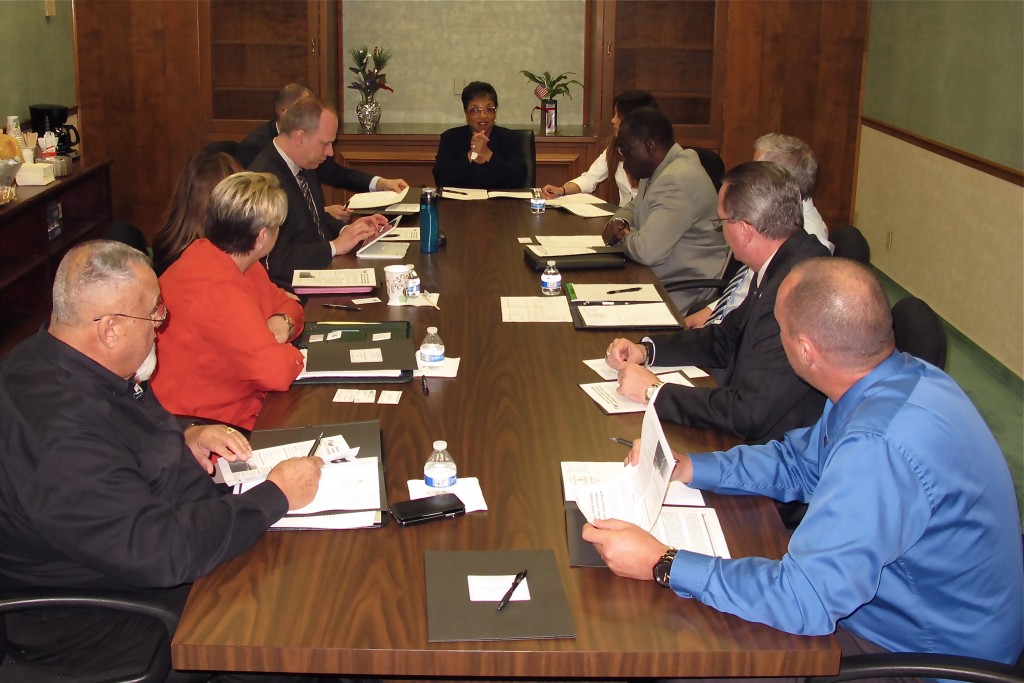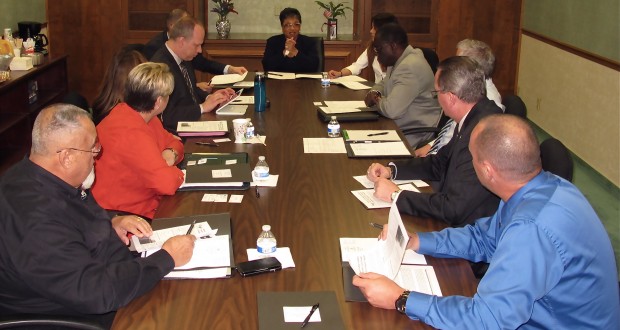
(L to R) General Manager Butch Araiza, West Valley Water District; General Manager Stacey Aldstadt, San Bernardino City Municipal Water Depart.; Deputy General Manager Robin Ohama, San Bernardino City Municipal Water Dept.; Principal Management Analyst Bob Page, San Bernardino County Administrative Office; Government Relations Director Josh Candelaria, San Bernardino County Administrative Office; Assemblymember Brown; Amanda Saechao, staff to Assemblymember Brown; Division Chief Kenneth Eke, San Bernardino County Department of Public Works; Principal Management Analyst Eric Grubb, Cucamonga Valley Water District; General Manager Robert Young, Fontana Water Company; and Asst. General Manager Josh Swift, Fontana Water Company.
SAN BERNARDINO, CA – Key water district leaders assembled for a meeting hosted by Assemblymember Cheryl R. Brown (D-San Bernardino) on Thursday, April 2, to discuss top priorities and funding opportunities following the passage of AB 91 and AB 92, the emergency drought relief package signed by Governor Brown on Friday, March 27.
These new laws were drafted and expedited because of the increasing severity of drought conditions. The law will allocate over $1 billion, which will fund various water projects in the most impacted areas.
“As a region, we need to work together to secure the dedicated funding to protect our water supply,” said Assemblymember Brown. “If we don’t start looking at how we’re going to maximize that funding across the state, we’re going to be left behind.”
Currently, the legislation will add $72 million to the General Fund, $272 million to Prop 1, $660 million to Prop 1E, and $57 million to various other projects.
“Although this funding is just a fraction of what’s needed, it should help stabilize our existing supplies,” said Assemblymember Brown.
The meeting, attended by county administrative and district leaders from San Bernardino Water Dept., Fontana Water Company, West Valley Water District, Colton Public Utilities, San Bernardino Valley Municipal Water District, and San Bernardino County Public Works, also discussed water storage, groundwater replenishment, water efficiency campaigns, water quality for fish and wildlife, and the Bay Delta Conservation Plan.
“The water agencies have been meeting monthly to go over groundwater levels and talk about strategies for groundwater management,” said General Manager Stacey Aldstadt, San Bernardino City Municipal Water Dept. “We’re going to package together a regional request for phasing in a variety of different projects to supplement the water supply. For us in this region, the critical issue is getting water back into the ground and how we find that water to put in the ground. We’re moving forward with a grant proposal that we’re packaging as a regional approach.”
“Concerning the Bay Delta Conservation Plan, we’ve lost about 20 percent from the State Water Project because of the environmental restrictions in the Delta,” said Water Resources Manager Robert Tincher, San Bernardino Valley Municipal Water District. “Basically, the Bay Delta Conservation Plan just finishes the State Project and moves the intake north.”
“The Bay Delta Conservation Plan is a local benefit to us,” said Aldstadt. “Groundwater has to be replenished, otherwise we have to start lowering groundwater levels. Normally we would get snow melt from Big Bear and Lake Arrowhead, but we’re not getting that. We’re all connected to the Delta so if we can’t get water supplies and we don’t have natural recharge, we have to rely on artificial recharge, which is recycled water or the State Project.”
Water conservation efforts continue to be a critical component of water management. On Tuesday, Governor Brown issued an Executive Order mandating restrictive water use. In his document, he directed the State Water Resources Control Board to impose a mandatory 25 percent reduction in state water resources.
“For the past several years, our region has been an innovator in water conservation, turf replacement programs, water efficient products, and the use of recycled water. We need to continue to conserve as much water as possible and address our water needs,” said Assemblymember Brown. “Our future depends on the decisions we make today.”
For more information, contact Ashley Jones at (909) 381-3238.
 Westside Story Newspaper – Online The News of The Empire – Sharing the Quest for Excellence
Westside Story Newspaper – Online The News of The Empire – Sharing the Quest for Excellence




